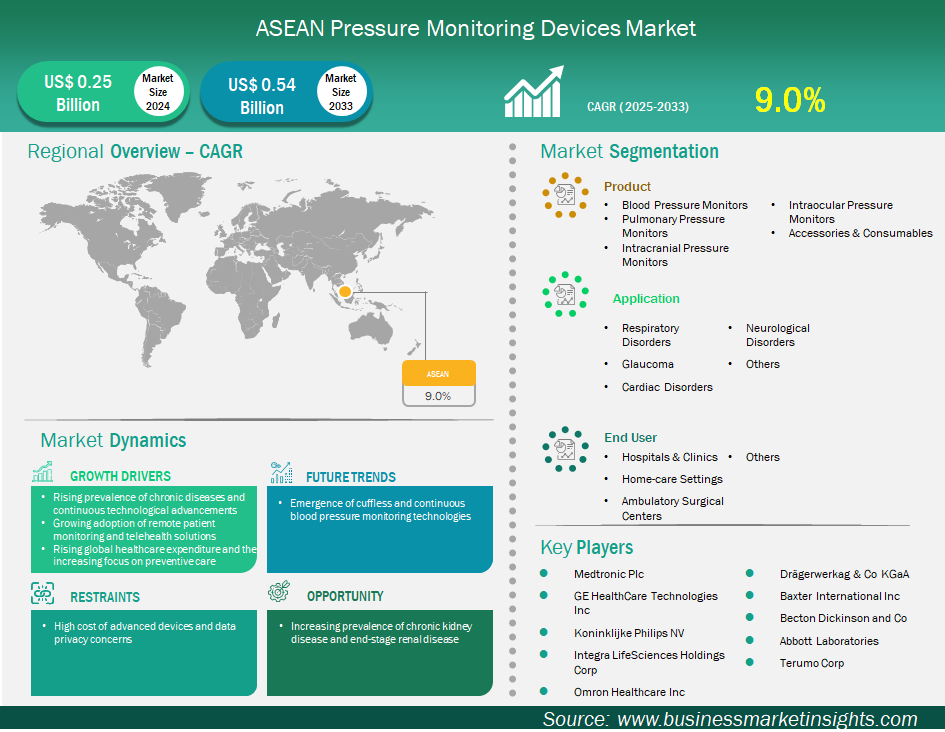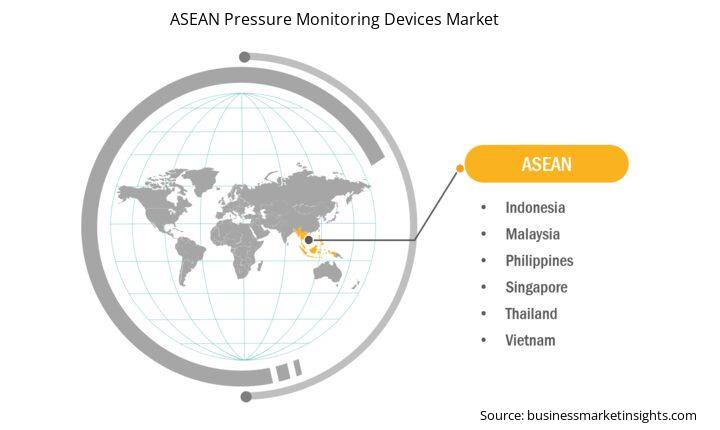ASEAN Pressure Monitoring Devices Market Outlook (2022-2033)
No. of Pages: 196 | Report Code: BMIPUB00031865 | Category: Life Sciences
No. of Pages: 196 | Report Code: BMIPUB00031865 | Category: Life Sciences
ASEAN pressure monitoring devices market size is expected to reach US$ 536.0 million by 2033 from US$ 246.4 million in 2024. The market is estimated to record a CAGR of 9.0% from 2025 to 2033.
The pressure monitoring devices market in ASEAN is benefitting from substantial growth driven by rising prevalence of chronic diseases and continuous technological advancements, growing adoption of remote patient monitoring and telehealth solutions, and rising global healthcare expenditure and the increasing focus on preventive care. An estimated 37 million people in ASEAN are affected by CVD, making it the leading cause of death and morbidity, with a 148% increase in all cases from 1990 to 2021, CVD death rates were higher than the rest of the world in Laos, Indonesia, the Philippines, Vietnam, and Malaysia (Institute for Health Metrics and Evaluation, May, 2025).
Hypertension affects nearly 30% of adults in Asia, with Malaysia, Thailand, and Indonesia experiencing a significant burden. For instance, in Malaysia, a study on adolescents showed a hypertension prevalence of 24.5% in urban areas, while Indonesia's adolescents showed a 2.6% hypertension prevalence). The high prevalence of these conditions necessitates widespread use of blood pressure monitors, both in clinical settings and for home use, as well as more specialized devices for cardiac diagnostics.

Key segments that contributed to the derivation of the pressure monitoring devices market analysis are product, application, and end user.
An increasing number of countries in ASEAN now want to provide technology-enabled solutions to healthcare payers, providers and patients, helped in no small part by the expanding use of telemedicine and remote patient monitoring (RPM). Singapore, Indonesia, Thailand, Vietnam and Malaysia have increasingly realised that a strong Digital health ecosystem can facilitate the development and deployment of various digital health solutions--helped by healthtech start-ups, underlying technologies, and government initiatives, in order to leverage telemedicine and remote care. In Indonesia, devices for wearables have increased approximately 50% between 2020 and 2023 spurred by the government recommending the use of wearable health devices, National Health Insurance Scheme (JKN) supports recognised teleconsultations, and remote monitoring as an essential aspect of the individual health and wellbeing. Moreover, with the ongoing telemedicine expansion, we are now able to monitor chronic health conditions, such as hypertension consistently at home, when we were limited to consultations in-setting. Patients are now empowered monitor their hypertension at home and provider and patients have the opportunity of access to real-time data to retrospectively optimise treatment. While a large amount of the device components and finished high-end medical devices in Southeast Asia are being imported, Malaysia and Thailand are recognised as having the capabilities to manufacture medical devices and considered manufacturing and distribution hubs for high-quality medical devices within Southeast Asia and beyond; and are focusing investment on continuing to build local capacity, while both Indonesia and Vietnam appreciate the rising demand for domestic production, and are also building out their capabilities. This local production, coupled with the rising associated healthcare needs of an aging population, increasing healthcare spending across the region, demonstrates a promising opportunity for pressure monitoring devices in ASEAN medical markets.
Based on region, the ASEAN pressure monitoring devices market is further segmented into Indonesia, Malaysia, Philippines, Singapore, Thailand, and Vietnam. The Indonesia held the largest share in 2024.
Indonesia represents the largest market for pressure monitoring devices in ASEAN. Indonesia's National Health Insurance (JKN) covers over 90% of the population as of March 2024, with the goal of universal coverage by the end of the year. There is significant investment in public and private hospitals. Malaysia's 2024 budget allocates MYR 4102 billion (USD 941 billion) for healthcare, creating opportunities for medical product development including patient monitoring. The Philippines is continuing with its Universal Health Care (LIHC) Act with 5.6% of its 2024 national budget going to health. Singapore emphasizes preventive care through initiatives like Healthier SG, which incentivizes individuals to manage their own health in a personalized way, with a supportive health spend. Thailand is already advancing its healthcare infrastructure with an eye to medical tourism, having 61 JCI-accredited medical facilities as of October 2023. Vietnam is also making strides in the health care space using AI and building on its telemedicine services, with a goal of being an ASEAN healthcare hub by 2030. These developments will inexorably lead to increased requirements for diagnostic and monitoring equipment, which includes pressure monitoring devices.
| Report Attribute | Details |
|---|---|
| Market size in 2024 | US$ 246.4 Million |
| Market Size by 2033 | US$ 536.0 Million |
| CAGR (2025 - 2033) | 9.0% |
| Historical Data | 2022-2023 |
| Forecast period | 2025-2033 |
| Segments Covered |
By Product
|
| Regions and Countries Covered | ASEAN
|
| Market leaders and key company profiles |
|
Medtronic Plc, GE HealthCare Technologies Inc, Koninklijke Philips NV, Omron Healthcare Inc, Baxter International Inc, Becton Dickinson and Co, Abbott Laboratories, Terumo Corp, Integra LifeSciences Holdings Corp, and Dragerwerkag & Co KGaA, are among the key players operating in the market. These players adopt strategies such as expansion, product innovation, and mergers and acquisitions to stay competitive in the market and offer innovative products to their consumers.
The following methodology has been followed for the collection and analysis of data presented in this report:
The research process begins with comprehensive secondary research, utilizing both internal and external sources to gather qualitative and quantitative data for each market. Commonly referenced secondary research sources include, but are not limited to:
Note: All financial data included in the Company Profiles section has been standardized to US$. For companies reporting in other currencies, figures have been converted to US$ using the relevant exchange rates for the corresponding year.
Business Market Insights conducts a significant number of primary interviews each year with industry stakeholders and experts to validate and analyze the data and gain valuable insights. These research interviews are designed to:
Primary research is conducted via email interactions and telephone interviews with industry experts across various markets, categories, segments, and sub-segments in different regions. Participants typically include:

The ASEAN Pressure Monitoring Devices Market is valued at US$ 246.4 Million in 2024, it is projected to reach US$ 536.0 Million by 2033.
As per our report ASEAN Pressure Monitoring Devices Market, the market size is valued at US$ 246.4 Million in 2024, projecting it to reach US$ 536.0 Million by 2033. This translates to a CAGR of approximately 9.0% during the forecast period.
The ASEAN Pressure Monitoring Devices Market report typically cover these key segments-
The historic period, base year, and forecast period can vary slightly depending on the specific market research report. However, for the ASEAN Pressure Monitoring Devices Market report:
The ASEAN Pressure Monitoring Devices Market is populated by several key players, each contributing to its growth and innovation. Some of the major players include:
The ASEAN Pressure Monitoring Devices Market report is valuable for diverse stakeholders, including:
Essentially, anyone involved in or considering involvement in the ASEAN Pressure Monitoring Devices Market value chain can benefit from the information contained in a comprehensive market report.